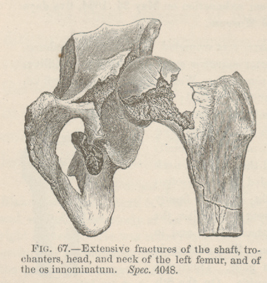Title: Patterson, D. N.
Source text: The Medical and Surgical History of the War of the Rebellion. (1861-65.), Part 3, Volume 2 (Washington, DC: Government Printing Office, 1883), 110-111.
Civil War Washington ID: med.d2e5944
TEI/XML: med.d2e5944.xml
CASE 259.—Lieutenant D. N. Patterson, 46th Virginia, aged 31 years, was wounded at an engagement on the Boydton Plank Road, near Petersburg, March 29, 1865, and was captured and sent to City Point, and immediately conveyed on an hospital transport to Washington, and placed in Armory Square Hospital on April 2d. On examination, it was found that a conoidal ball had entered the left thigh behind the trochanter major, and had passed inward and forward, fracturing the trochanter, neck, and head of the femur, and the anterior border of the acetabulum. On the day after the patient's admission, five days subsequent to the reception of the injury, Surgeon D. W. Bliss, U. S. V., in charge of the hospital, decided that the case was one in which excision of the upper extremity of the femur was applicable. The wounded man was anxious that an operation should be performed, and his general condition was very satisfactory. On April 3d he was placed under the influence of chloroform, and Surgeon Bliss exposed the fractured bone by a curvilinear incision with its convexity forward. The shattered fragments of the neck were extracted, the rent in the capsular ligament was enlarged and the round ligament was divided, and the head of the femur was exarticulated. It was found that the ball had not only comminuted the head, neck, and great trochanter, but that fissures extended down the shaft of the femur. The bone was divided by the chain saw two inches below the trochanter minor. The deep wound was now washed out, and small fragments of bone were removed, and search was made for the ball. It was finally detected by means of a Nélaton probe deeply buried in the obturator muscle near the posterior margin of the obturator foramen. The operation was accomplished with little loss of blood, and the patient reacted satisfactorily. The wound was lightly dressed, sufficient outlet for discharges being left, and the limb was extended and supported by pillows. Careful nursing was provided, and such stimulants and concentrated nourishment as seemed best adapted to the patient's condition. For three days he progressed very satisfactorily. Notwithstanding the extensive lesions of the pelvis, which were not detected until after death, there was no indication of peritonitis or disturbance of the urinary organs. On April 7th, however, profuse hæmorrhage took place, which could not be controlled, and the patient died on the morning of that day. At the autopsy it was found that the bleeding had proceeded from the internal iliac vein, gradually worn away by a sharp bit of bone forced inward by the ball. The pathological specimen, represented in the adjoining wood-cut (FIG. 67), is also figured at page 246 of the Catalogue of the Surgical Section of the Army Medical Museum, where another view is given.
